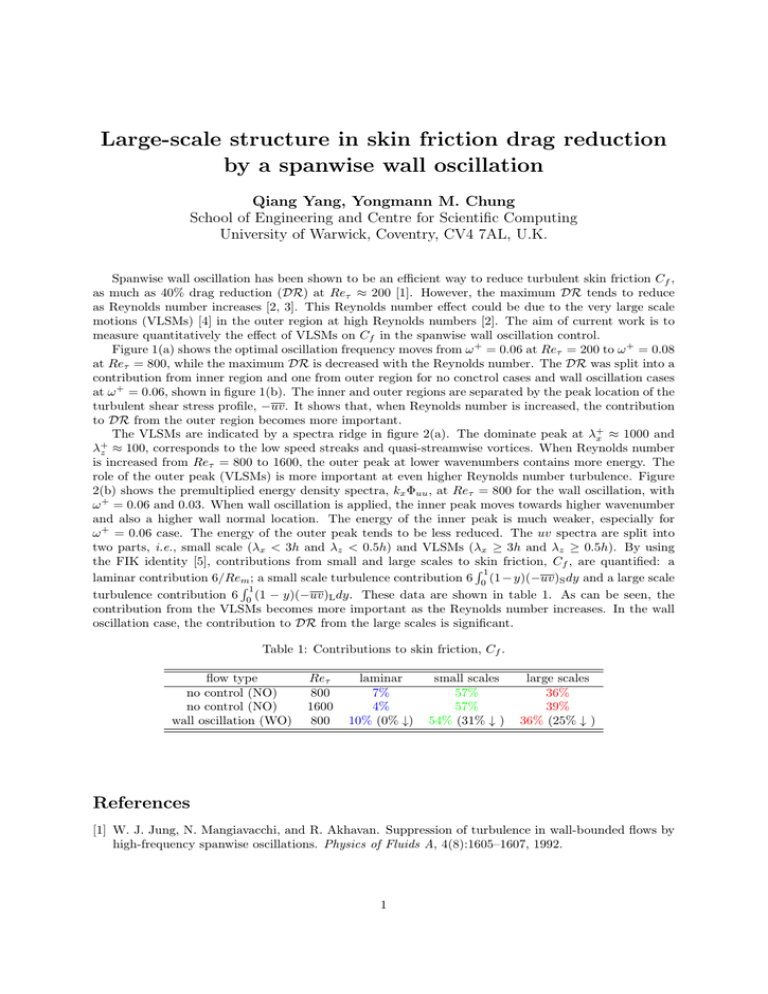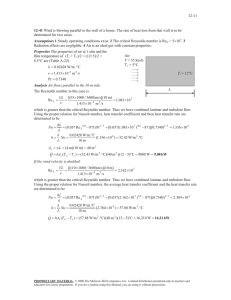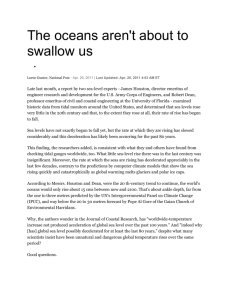Large-scale structure in skin friction drag reduction
advertisement

Large-scale structure in skin friction drag reduction by a spanwise wall oscillation Qiang Yang, Yongmann M. Chung School of Engineering and Centre for Scientific Computing University of Warwick, Coventry, CV4 7AL, U.K. Spanwise wall oscillation has been shown to be an efficient way to reduce turbulent skin friction Cf , as much as 40% drag reduction (DR) at Reτ ≈ 200 [1]. However, the maximum DR tends to reduce as Reynolds number increases [2, 3]. This Reynolds number effect could be due to the very large scale motions (VLSMs) [4] in the outer region at high Reynolds numbers [2]. The aim of current work is to measure quantitatively the effect of VLSMs on Cf in the spanwise wall oscillation control. Figure 1(a) shows the optimal oscillation frequency moves from ω + = 0.06 at Reτ = 200 to ω + = 0.08 at Reτ = 800, while the maximum DR is decreased with the Reynolds number. The DR was split into a contribution from inner region and one from outer region for no conctrol cases and wall oscillation cases at ω + = 0.06, shown in figure 1(b). The inner and outer regions are separated by the peak location of the turbulent shear stress profile, −uv. It shows that, when Reynolds number is increased, the contribution to DR from the outer region becomes more important. The VLSMs are indicated by a spectra ridge in figure 2(a). The dominate peak at λ+ x ≈ 1000 and + λz ≈ 100, corresponds to the low speed streaks and quasi-streamwise vortices. When Reynolds number is increased from Reτ = 800 to 1600, the outer peak at lower wavenumbers contains more energy. The role of the outer peak (VLSMs) is more important at even higher Reynolds number turbulence. Figure 2(b) shows the premultiplied energy density spectra, kx Φuu , at Reτ = 800 for the wall oscillation, with ω + = 0.06 and 0.03. When wall oscillation is applied, the inner peak moves towards higher wavenumber and also a higher wall normal location. The energy of the inner peak is much weaker, especially for ω + = 0.06 case. The energy of the outer peak tends to be less reduced. The uv spectra are split into two parts, i.e., small scale (λx < 3h and λz < 0.5h) and VLSMs (λx ≥ 3h and λz ≥ 0.5h). By using the FIK identity [5], contributions from small and large scales to skin friction, Cf , are quantified: a R1 laminar contribution 6/Rem ; a small scale turbulence contribution 6 0 (1 − y)(−uv)S dy and a large scale R1 turbulence contribution 6 0 (1 − y)(−uv)L dy. These data are shown in table 1. As can be seen, the contribution from the VLSMs becomes more important as the Reynolds number increases. In the wall oscillation case, the contribution to DR from the large scales is significant. Table 1: Contributions to skin friction, Cf . flow type no control (NO) no control (NO) wall oscillation (WO) Reτ 800 1600 800 laminar 7% 4% 10% (0% ↓) small scales 57% 57% 54% (31% ↓ ) large scales 36% 39% 36% (25% ↓ ) References [1] W. J. Jung, N. Mangiavacchi, and R. Akhavan. Suppression of turbulence in wall-bounded flows by high-frequency spanwise oscillations. Physics of Fluids A, 4(8):1605–1607, 1992. 1 500 200 60 100 T+ 50 1 0.8 C f / C f0 DR 40 20 Reτ=200 Reτ=400 Reτ=800 Reτ=1600 0 -20 (a) 0 0.05 0.1 ω+ 0.15 0.6 0.4 Outer Inner Laminar 0.2 0 0.2 (b) 500 1000 1500 2000 Reτ Figure 1: (a) Shift of optimal oscillation frequency; (b) Cf contributions from laminar component, inner and outer regions for wall oscillation with ω + = 0.06 (solid lines), and no control cases (dashed lines). (a) (b) Figure 2: (a) Premultiplied uu energy density spectra, kx kz Φuu for Reτ = 800 (lines) and 1600 (shaded) at y + ' 15; (b) premultiplied energy density spectra, kx Φuu , comparison among no control case (shaded), ω + = 0.06 oscillation case (red lines) and ω + = 0.03 oscillation case (yellow lines) at Reτ = 800. [2] E. Touber and M. A. Leschziner. Near-wall streak modification by spanwise oscillatory wall motion and drag-reduction mechanisms. Journal of Fluid Mechanics, 693:150–200, 2012. [3] E. Hurst, Q. Yang, and Y. M. Chung. The effect of Reynolds number on turbulent drag reduction by streamwise travelling waves. Journal of Fluid Mechanics, under review, 2014. [4] N. Hutchins and I. Marusic. Evidence of very long meandering features in the logarithmic region of turbulent boundary layers. Journal of Fluid Mechanics, 579:1–28, 2007. [5] K. Fukagata, K. Iwamoto, and N. Kasagi. Contribution of Reynolds stress distribution to the skin friction in wall-bounded flows. Physics of Fluids, 14(11):L73–L76, 2002. 2








